Genesis' flagship showroom opened in Hong Kong Plaza in 2021, with a contemporary Korean restaurant located on the second floor in collaboration with restaurateur Chef Tom Ryu Taehyeok (Jeju Sagye, Pado), Onjium (a Michelin star restaurant in Seoul, Korea), and mixologist Michael Chen (Dentree, The Cannery), who together helped create the venue's food and drinks menu.

Image by Sophie Steiner/That's
The venue fits the luxury car experience mold – sleek modern décor, minimalistic with curved lines and dark detailing, streamlined layout accented by nuanced design elements.
Everything has its purpose; nothing is superfluous.
READ MORE: Luxury Car Experience Meets Modern Korean Cuisine at Genesis
The Food
The menu centers around two sets that balance current and classic Korean cuisine – one designed by Onjium and one by Chef Tom. Both menus have been refreshed with seasonal ingredients specifically to help beat the heat during these sizzling summer months.
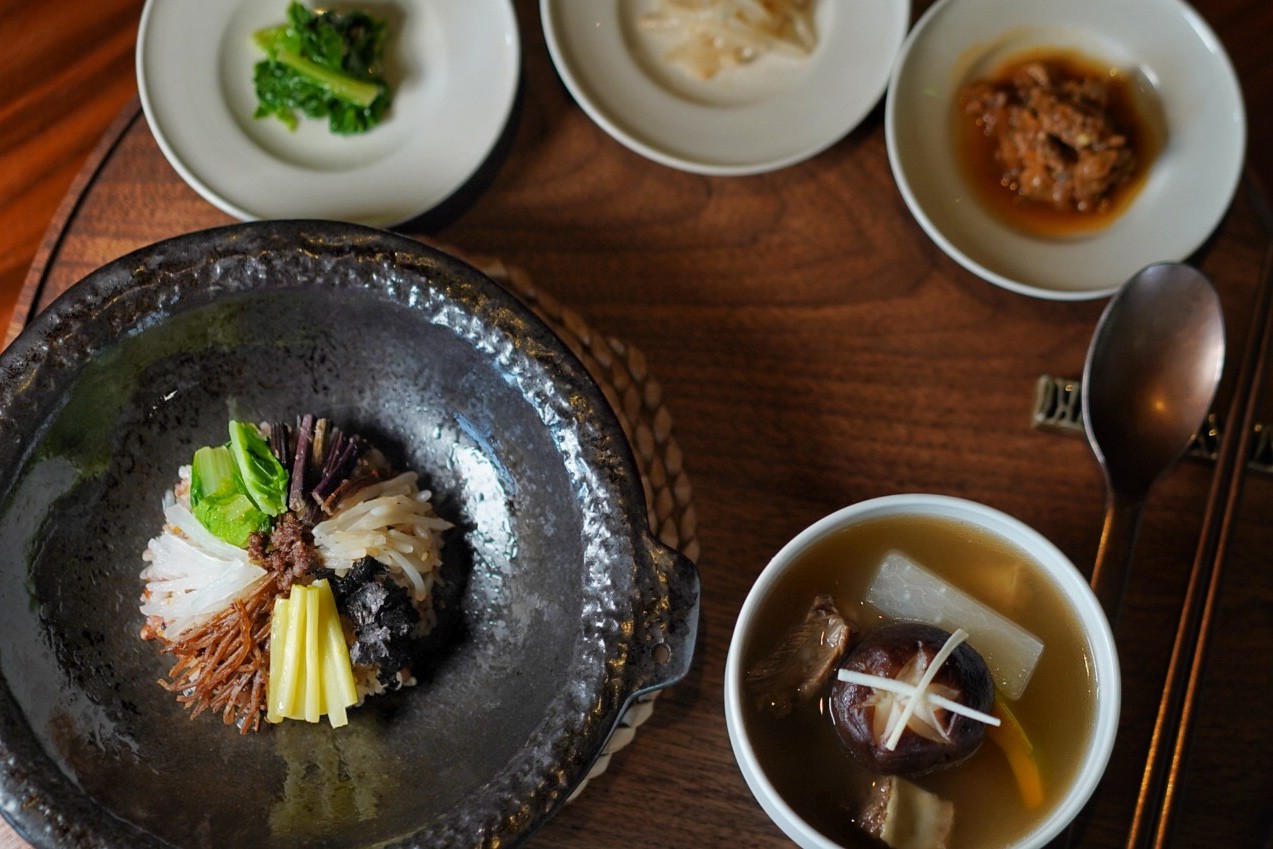
Image by Sophie Steiner/That's
Together, they provide a contemporary take on traditional Korean food that carries diners through the past, present and future of Korea.
All dishes from the set, plus a few extras, are also available as a la carte options.
First up, there’s the Inspiration Set by Onjium (RMB588), one that is inspired (hence the name) by the historic recipes of Korea’s past, focusing on natural ingredients that culminate in delicate flavors.
Slightly more whimsical – but still honoring Korean culinary traditions – Chef Tom’s Ingenuity Set (RMB588) is all about pairing modern elements while preserving the essence of Korean cuisine.
Our suggestion: Go with a friend and order one of each, as both sets – as a whole – complement each other.
Onto the Korean feast…
The starters are both a version of a cold seafood salad, emphasizing different aspects of said dish.

Image by Sophie Steiner/That's
The former takes a present-day stance on Bada Mulhoe – a spicy medley of oceanic seafood, customarily eaten in summer – drizzled in an omija sauce made from dried magnolia berry.
Meaning “five tastes” in Korean, ruby-hued omija is a pungent berry, usually used in making tea as it encompasses sweetness, sourness, bitterness, and saltiness.
The omija broth is poured over a “Korean ceviche” – as Chef Tom calls it – of abalone, squid, scallops, and glistening cubes of tuna belly crowned with sea grapes.

Image by Sophie Steiner/That's
The seafood takes a backseat in the Inspiration set's Gyeojachae, with cucumber, carrot, sprouts, beef, and sliced egg arranged in colorful stripes with abalone and squid, all topped with an aromatic mustard sauce.
The second course is summer-forward, honing in on two warm-weather dishes that Koreans regularly dine on during the hottest months of the year – stewed chicken and fried eel.
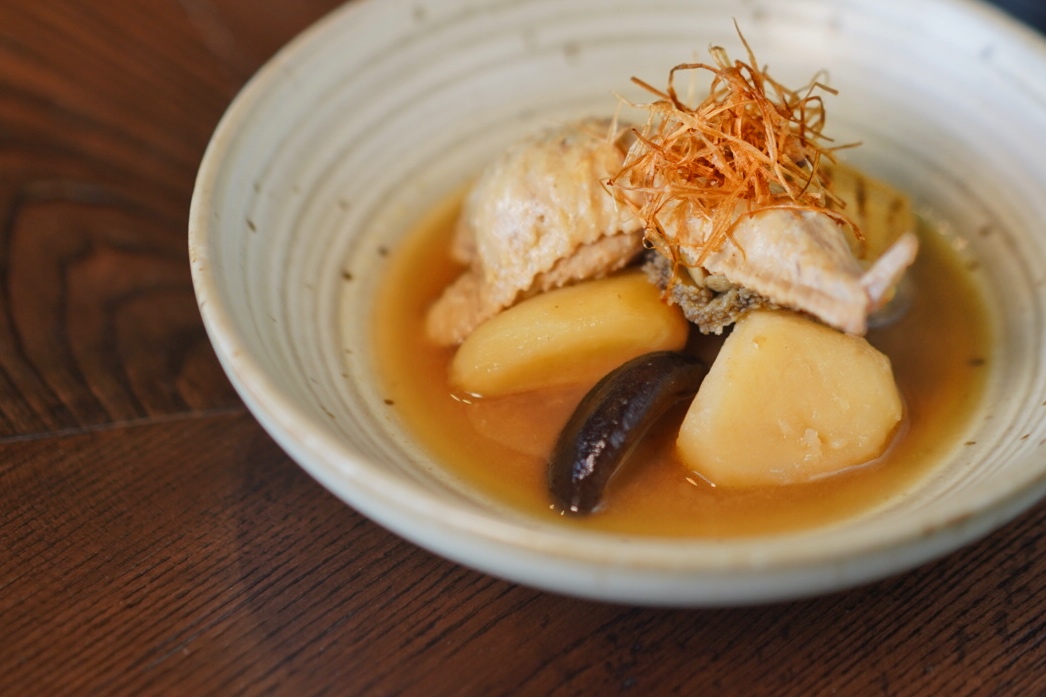
Image by Sophie Steiner/That's
The Inspiration set’s Yeongyae Jjim is a stewed chicken dish consumed in summer that follows the ethos of “fighting fire with fire” – eating warm foods in warm weather. The layered broth is nuanced and rich, a flavor that results only from long hours of simmering in the kitchen.
A chicken wing is stuffed with a ground beef and pork mixture, and stewed alongside a springy abalone, shitake mushrooms, and potatoes that melt on the tongue as if they were pre-mashed.
Another summer must-eat, freshwater river eel is prized for its high physical endurance that affords these soft-finned fish the ability to swim thousands of kilometers upstream.
Korean people traditionally believe that, by eating the eels, they too will have improved stamina to make it through the steamiest of months.

Image by Sophie Steiner/That's
Said Fried Eel with Bok Bun Ja (from the Ingenuity set) are buttery, the tender meat encased in a lace-like fried batter crust, best enjoyed dipped in a puddle of homemade raspberry syrup.
A wispy chrysanthemum side salad is refreshingly grassy, sprinkled with white sesame seeds.
The third course takes diners into the meat section of the menu, with the Ingenuity set’s boneless beef short rib and the Inspiration set’s pork neck.
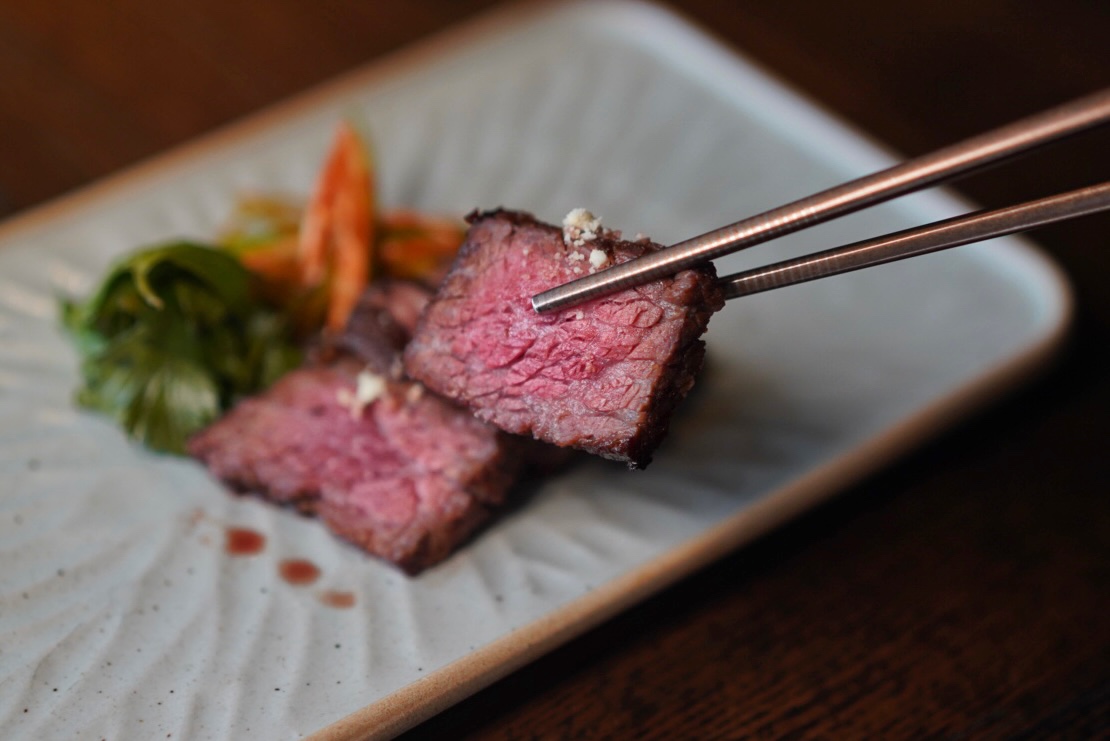
Image by Sophie Steiner/That's
The Woodae Galbi’s name refers to the unconventional vertical cut of beef short rib, one that translates to a boneless bite, yet still pleated with a high fat-to-meat ratio for a succulent mouthfeel.
A dribble of plum soy sauce, a dusting of crushed cashews, a crunch from asparagus and garlic stem kimchi, and a burst of herbaceousness from balsamic vinegar-marinated Italian parsley salad all cut through the meat’s unctuousness, creating a combination of nibbles that create a whole better than the sum of its parts.
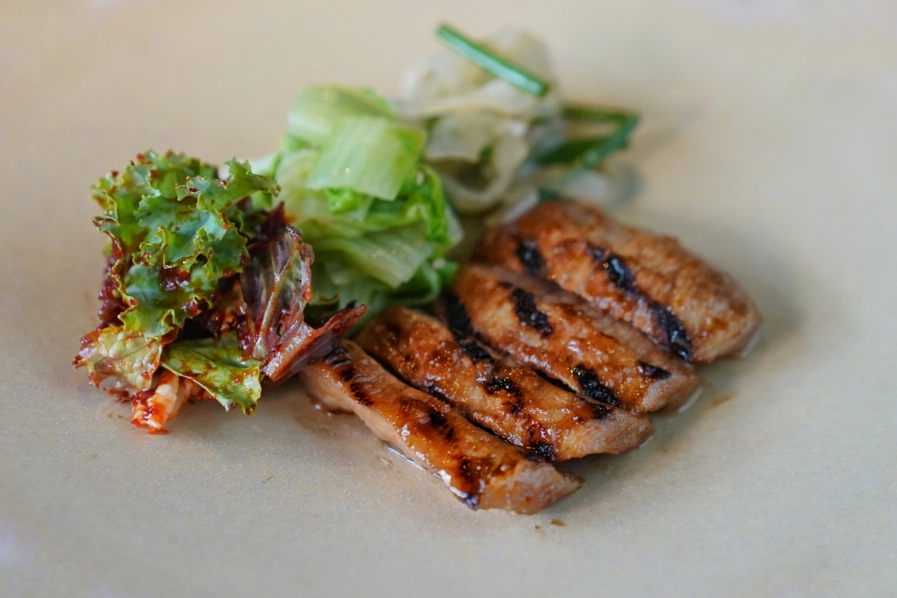
Image by Sophie Steiner/That's
During the Goryeo Dynasty (918-1392), the Yuan Dynasty called the Korean nation “maekjeok,” referring to the roast meat prepared for the people.
Hence the doenjang-marinated Maekjeok – or soybean paste pork jowl – a dish to be savored by all, served with a fresh salad kimchi, sesame oil sautéed cabbage, and pickled onions.
The mains showcase archetypal dishes, ones with roots dating back nearly a millennium: the Inspiration set’s short rib soup with hot stone bibimbap; and the Ingenuity set’s beef stew with a seafood-centric rice.

Image by Sophie Steiner/That's
With a history of more than 800 years, there’s a reason Insam Galbitang, or short rib soup, is still one of Korea’s most popular dishes.
The comforting broth is enhanced by ginseng, daikon, and – most notably – behemoth short rib bones covered in tender flesh.

Image by Sophie Steiner/That's
Alongside arrives the Hwaban, meaning “flower plate,” named for the decorative presentation of the vegetables topping the steamed rice – radish, cabbage, asparagus, sprouts, seaweed, bracken, and burdock root.
The nutty purple grains are served with housemade seafood beef sauce and a variety of banchan, providing an imaginative interplay of textures and flavors that – no wonder – has stood the test of time.

Image by Sophie Steiner/That's
An indulgent twist on Korea’s favorite rice dish, the Uni Yak Gochujang Bibimbap is a textbook example of this crowd pleaser.
Custardy sea urchin melts into the rice – kernels that have been cooked in a chicken, tomato and shrimp stock. The yak – meaning stir-fried – gochujang (Korea's famous fermented red chili paste) is sautéed with diced shitakes and shrimp, dolloped atop a cabbage salad.
The fun is in the mix – getting a lick of uni, a chew of mushroom, a nip of gochujang spice, and a crunch of crispy rice – in one all-encompassing mouthful.
A traditional Korean jelly dessert from the Joseon Dynasty (1392-1897) called gwapyeon, the Surahyang rounds out the Inspiration set, incorporating a middle tier of orange segments, hence the name, which comes from a prized breed of Korean oranges.
Reminiscent of a 1950s jello mold dotted with fruits, this the bouncy jelly is finished with butterfly orchid petals, while a splash of passion fruit apple wine adds a citrusy pop.
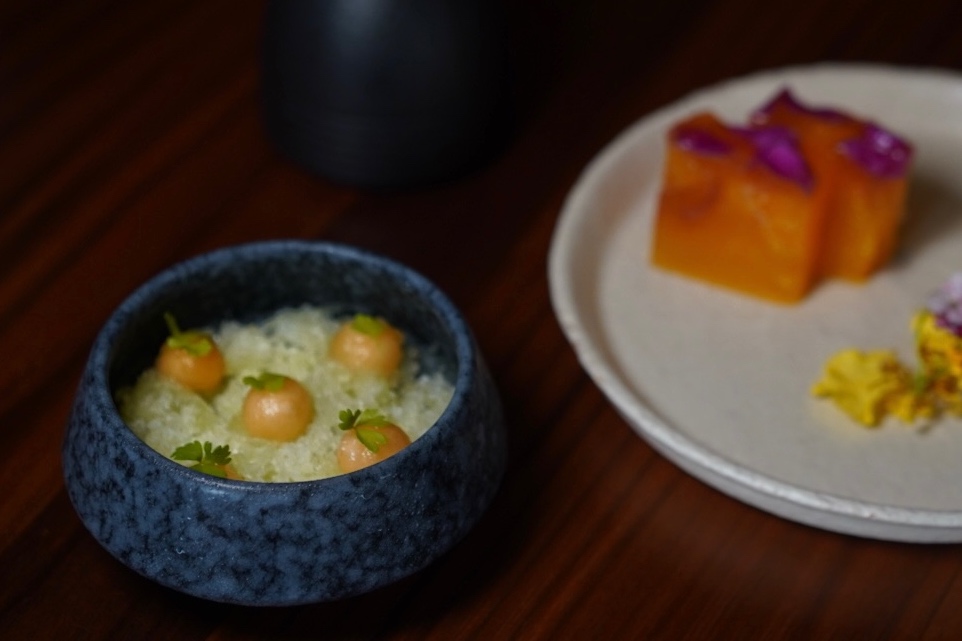
Image by Sophie Steiner/That's
Melon Hwachae – meaning “fruit punch” in Korean – is frozen into a sorbet made from melon, yuzu, and lemon, then scraped like a shaved ice or granita and studded with spheres of melon and micro-parsley for the Ingenuity sets concluding bite.
The Drinks
As for drinks, Michael Chen has put together a roster of Korean-inspired bevvies, going far beyond just the use of soju or kimchi flavors.

Image by Sophie Steiner/That's
Case in point, the Dakgangjeong Sour (RMB108) comes from the interplay between a whiskey sour and sweet and crispy Korean fried chicken
Utilizing a gochujang distillate, Johnny Walker Double Black and Naked Malt whiskeys are blended with spiced lemon shrub, salted honey, pineapple and sesame oil for a refreshingly tart sipper.

Image by Sophie Steiner/That's
The Gochukara Margarita (RMB108) sees a gochukara spice-infused agave syrup – the same spice used in making kimchi – shaken with Codigo 1530 Blanco tequila, mezcal, citrus and tangerine lemongrass shrub, ensuring your taste buds tingle with fiery heat with every gulp.
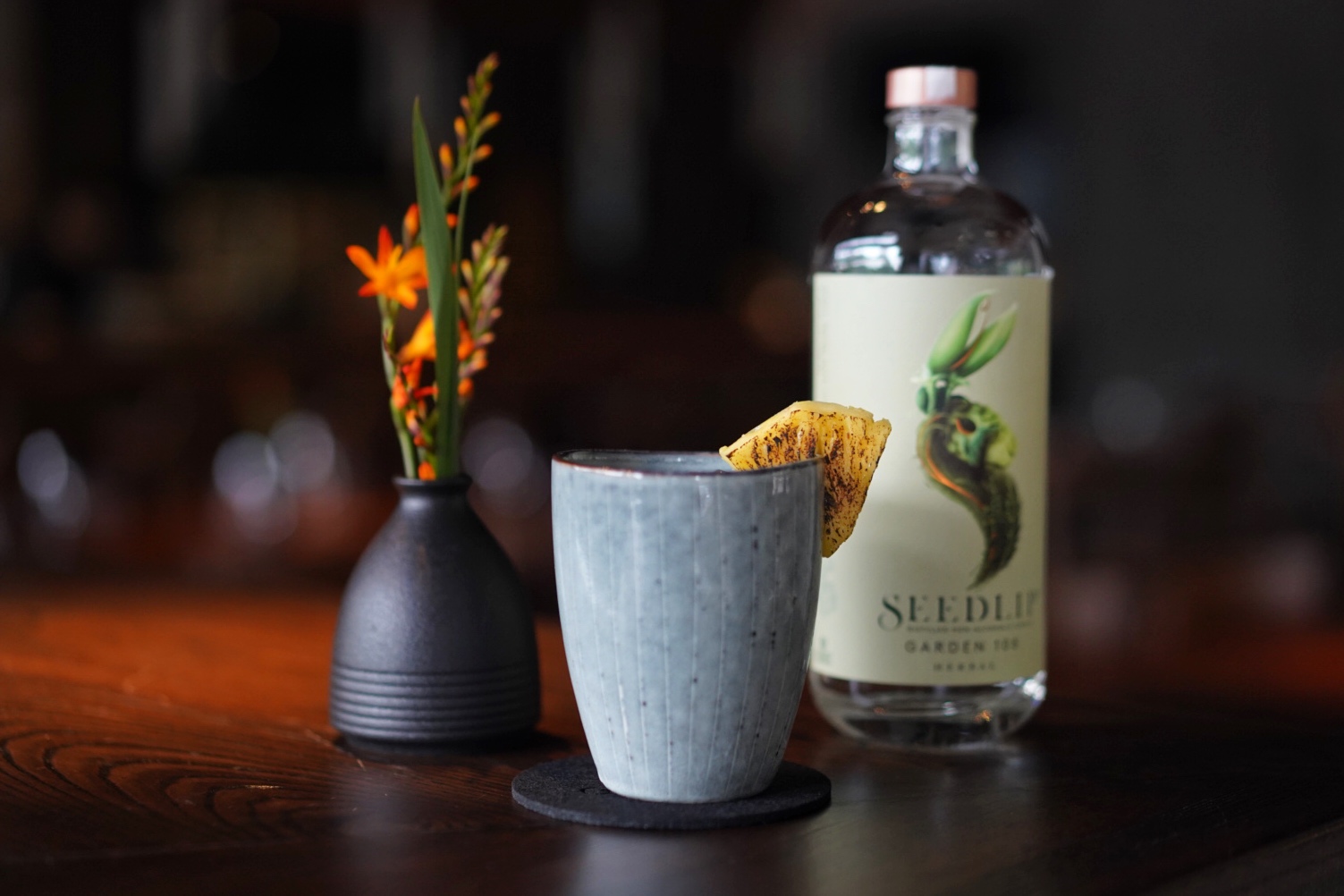
Image by Sophie Steiner/That's
There’s also a handful of non-alcoholic drinks that are equally impressive, like the Pineapple Galaxy (RMB78) showcasing Seedlip Garden 108, hopped stone fruit kombucha, spiced lemon shrub, and a zip of salted honey, garnished with a charred pineapple wedge.
But the real creativity comes with the House-infused Sojus (RMB88) – spanning everything from ginseng to dandelion & burdock, buckwheat to green chili peppers, and shiso leaf to green tea with roasted rice.
Drinkers can choose their own soda, ginger ale, or Pao drink to turn it in a highball.

Image by Sophie Steiner/That's
But wait. The deal gets even better. During the month of July, from 8-10pm, Genesis offers free flow highballs – of any of the above mentioned infused sojus, plus classic soju and whiskey (like Johnny Walker Double Black, Chivas Regal Mizunara, Naked Malt, and Monkey Shoulder) – for just RMB88.
Yes, you read that correctly. For the price of one highball, you can spring for as many highballs in as many flavor combinations as you can think of.
Every. Single. Evening.
(Until July 31)
Genesis also offers weekend brunch – with many smaller versions of dinner menu dishes, plus a lineup of brunch cocktails – think kimchi Bloody Marys, and refreshing spritzes.
Weekdays sport more of a daytime café vibe with afternoon tea sets, plus Korean desserts and snacks available from 11am-3pm, followed by dinner rolling into late night drinks and snacks.
Genesis, 282 Huaihai Zhong Lu, by Huangpi Nan Lu, 淮海中路282号,近黄陂南路.
[Cover image by Sophie Steiner/That's]
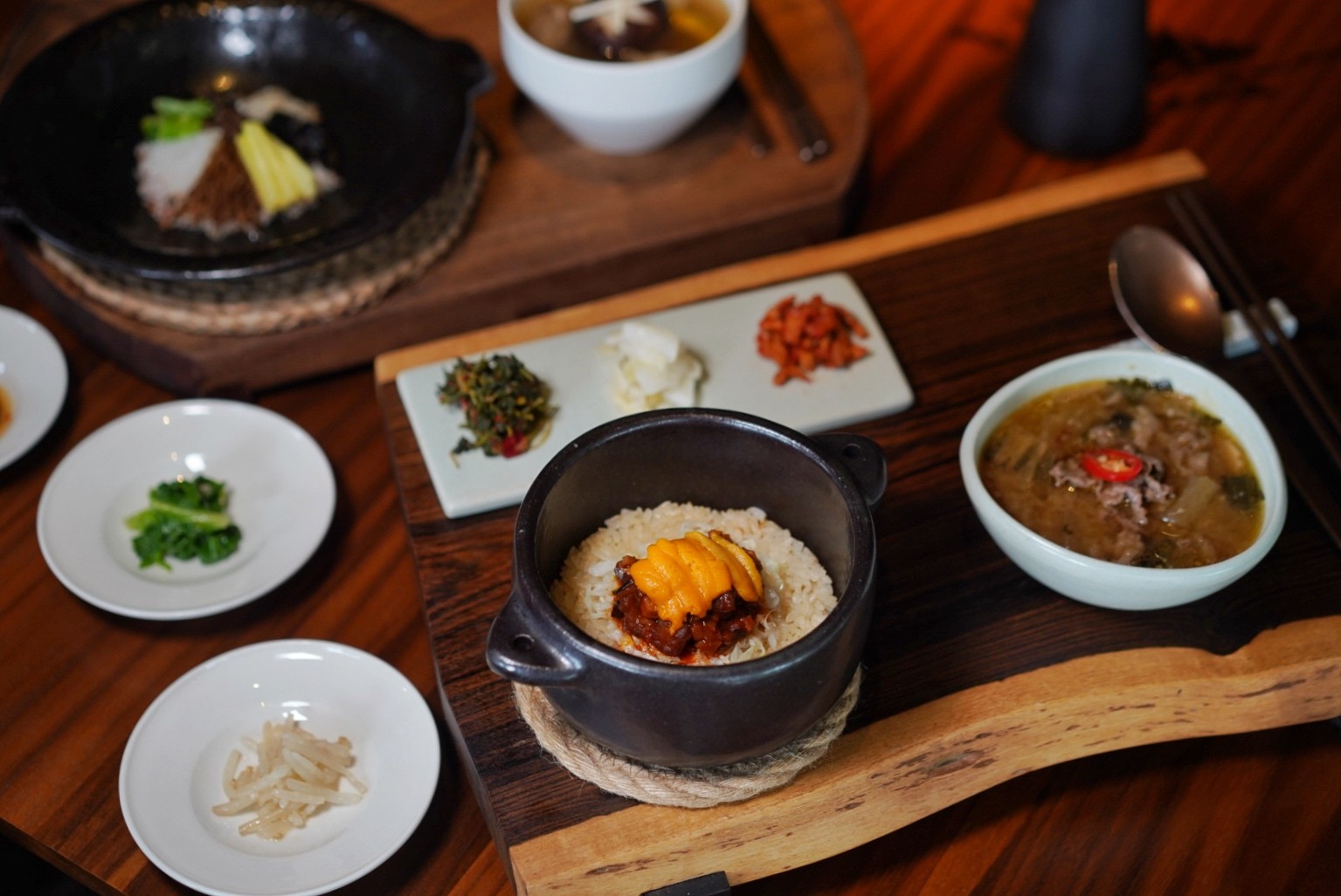




















0 User Comments